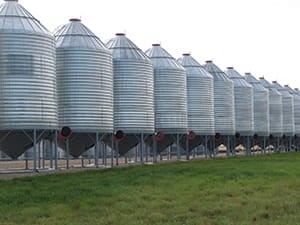TISDALE — When harvesting crops with uneven maturity and higher moisture content, storage problems can be a concern. Monitoring grain moisture as it is placed in storage is critical to avoiding disasters like fungal growth, spoiled grain and insect infestations. In some cases, early marketing and/or drying may be the only options for high-moisture crops.
Even if the average moisture content of the grain is below the safe storage limit, high green counts, uncured kernels and plant material, hot grain or moisture migration can cause pockets of tough grain. There is potential for all these factors to become a significant issue with the excessive amount of regrowth happening during this year’s harvest. Close monitoring, turning, cooling and/or drying may be needed to ensure safe storage of these grains for any length of time.
However, moisture is not the only thing that can affect grain storage. The type and condition of the storage facility may also be a factor. Moisture intrusion is usually less of a concern with newer metal bins, but older bins and wooden granaries tend to require annual upkeep to ensure they are weather–tight. All bins should be cleaned prior to filling.
During large crop years, bin space can be at a premium. In this case, some grain will undoubtedly be placed on the ground with or without rings and with or without covers. It is difficult to avoid some loss with this form of storage but locating them on higher ground and using a ground sheet can help minimize this.
A newer method of storage is the temporary grain bag. One of the advantages of this method is that the grain can be stored in the same field in which it was grown, reducing trucking time. However, there are some precautions that should be observed when storing grain in bags. One is that it is desirable that the grain be clean and dry when put into these containers. Turning is not an option because the bag is destroyed to remove the grain. As with any other storage facility, monitoring for signs of spoilage is critical. Wildlife damage can also be a problem. Marketing the grain promptly may be required if wildlife damage occurs.
Regularly monitoring grain temperature change in storage will give the best chance to address concerns before they become a storage problem. In the interest of saving time, it is sometimes tempting to just keep an eye on situations where we suspect problems. This can be a recipe for disaster so, recommendations are to check all storage at least bi-weekly until freeze up and then monthly. Automated temperature monitors can be helpful as an early warning system but should not be relied on as the only form of monitoring. Physical inspection, looking for signs of crusting at the top, noticeable odours, insects or substantial rise in temperatures will indicate that the grain requires attention.
For more information on grain storage risks please contact your local crops extension specialist or the Agriculture Knowledge Centre at 1-866-457-2377.
— Kim Stonehouse, MSc, Pag is Crops Extension Specialist at Tisdale
Bookmark SASKTODAY.ca, Saskatchewan's home page, at this link.

